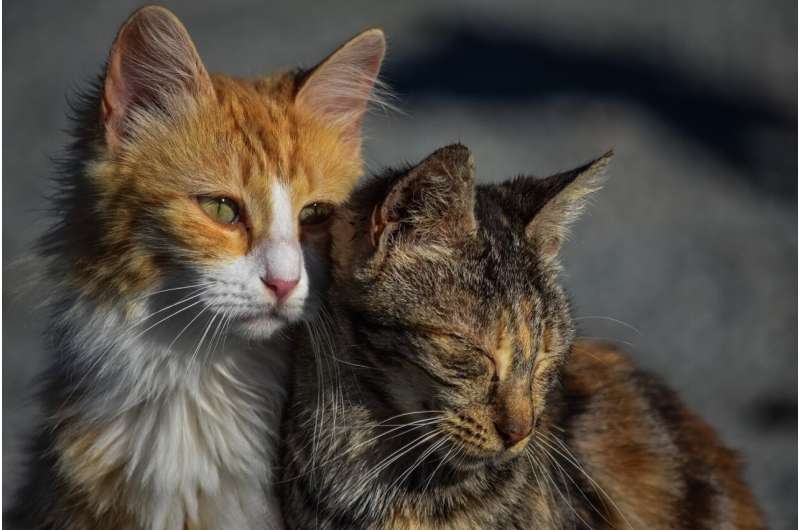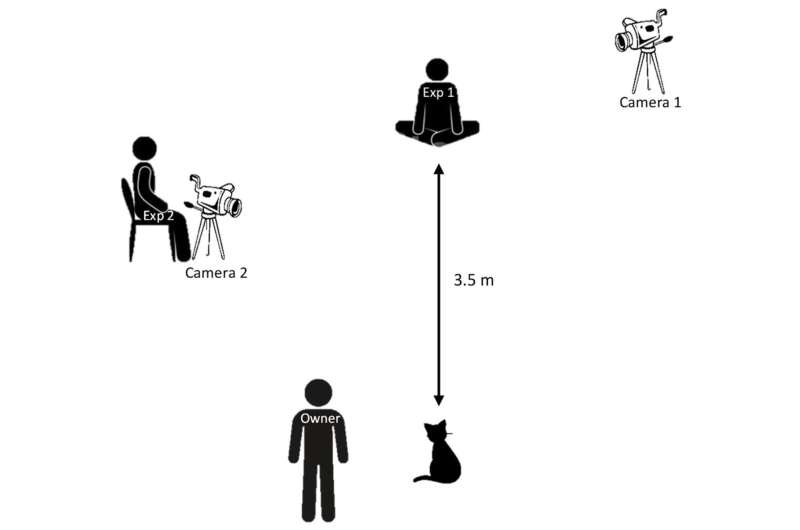May 9, 2023 report
This article has been reviewed according to Science X's editorial process and policies. Editors have highlighted the following attributes while ensuring the content's credibility:
fact-checked
peer-reviewed publication
trusted source
proofread
French felines found to be less responsive to cat calls with faster attraction to visual cues

Researchers Charlotte de Mouzon and Gérard Leboucher of the Laboratoire Ethologie Cognition Développement, Université Paris Nanterre in France, have examined preferred feline etiquette when faced with an unfamiliar human. In the paper, "Multimodal Communication in the Human–Cat Relationship: A Pilot Study," published in Animals, researchers examined four modes of human interactions—vocal, visual, bimodal and a no communication control—with a dozen cats living in cat cafés.
Twelve cats living at two cat cafés in Bordeaux and Toulouse, France, were observed during the study, narrowed down from a group of 18. The six not included in the study were either overly wary of humans or just could not be bothered to interact with them.
By analyzing video clips of cat-human interactions, the research team found that the modality of communication significantly affected the time it took for cats to approach the human experimenter. Cats interacted significantly faster with visual and bimodal communication than with vocal communication alone and a control condition of no communication.
In addition, the communication modality had a significant effect on tail-wagging behavior. Cats displayed significantly more tail wagging when the experimenter engaged in the no communication control compared to visual and bimodal communication modes, indicating to researchers that they were less comfortable in this control condition. Cats also displayed more tail wagging in response to vocal communication than bimodal communication.
The experiment was conducted in the quiet of the morning before opening the café to the public. Two experimenters were present in the café. Experimenter 1 was sitting and engaged in communication according to each testing condition. Experimenter 2 recorded video of the interactions and sat still throughout the experiments. For each test, the cat entered the room with their owner (café owners at both locations), who was asked not to communicate with the cat. The testing conditions were then initiated.

The four modes
In the no communication control, experimenter 1 did not look at or speak to the cat. She sat still and did not offer her hand. Six cats still were sufficiently curious enough to approach the experimenter.
With vocal communication, experimenter 1 alternated calling the cat by their name and making cat-specific calling noises, described in the paper as "…a sort of 'pff pff' sound, widely used by French humans for calling cats," but did not offer her hand and looked upwards to avoid eye contact. Seven cats responded to the calls by approaching, just one more than by no communication.
Ten approached in the visual mode, where the experimenter silently offered her hand to the cat and alternated gaze directed at the cat with gaze directed at the floor. Because narrowing of the eyes may be perceived as positive communication between cats and humans, experimenter 1 engaged in a neutral gaze with slow blinking sequences.
A fourth mode of bimodal (visual and vocal) communication had experimenter 1 offering her hand to the cat and cycled between directing her gaze at the cat (slow blinks) and directing her gaze at the ground while also calling the cat by name and making french-specific cat calling noises. Nine cats approached, signifying either an increased response to cat calls with a visual component or a decrease compared to just visual cues alone.
Throughout testing conditions, experimenter 1 hid treats in her pocket but did not offer the treat unless the cat came within a distance of 10 cm. If the cat did not approach experimenter 1 within 75 seconds, they were whisked away and received a treat at the door. While it is unclear what role the treats play in the overall study design, rewarding subjects for participating in an experimental trial is common, albeit usually in human trials.
Forty-eight video clips were generated, one video for each testing condition per cat, and coded using Behavioral Observation Research Interactive Software (BORIS). Statistical analysis was performed to compare cats' responses to the different testing conditions using the Friedman rank sum test, a widely-used method in computational biology.
Contrary to predictions when designing the study, the cats found visual communication more attractive than vocal communication initiated by an unfamiliar human. This can indicate a good study design when the results ignore potential prediction bias.
The results suggest that cats display a marked preference for visual and bimodal cues when being addressed by non-familiar humans compared to vocal cues. The authors speculate that this observation could serve as a basis for practical recommendations to navigate the codes of human-cat interactions.
More information: Charlotte de Mouzon et al, Multimodal Communication in the Human–Cat Relationship: A Pilot Study, Animals (2023). DOI: 10.3390/ani13091528
Journal information: Animals
© 2023 Science X Network



















